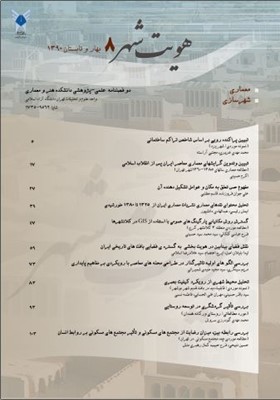بررسی الگو های اولیه تاثیرگذار در طراحی محله های معاصر با رویکردی بر مفاهیم پایداری
محورهای موضوعی : معماریمریم سینگری 1 , سید مجید مفیدی شمیرانی 2
1 - استادیار، گروه معماری و شهرسازی، واحد تبریز، دانشگاه آزاد اسلامی، تبریز، ایران
2 - استادیار دانشگاه آزاد اسلامی، واحد علوم و تحقیقات، تهران، ایران
کلید واژه: renewable energies, رشد هوشمند, Eco village, smart growth, رویکرد بوم گرایانه, مفاهیم پایداری, الگوهای طراحی محله در قرن بیستم, روستا-بوم, Ecological approach, Sustainable Concepts, Community designing paradigms of the twentieth century,
چکیده مقاله :
رویکرد بوم شناسانه طراحی فضاهای زیستی، نگرش نوینی را در متون شهرسازی قرن حاضر رقم زده و تعاملی میان مجتمع های زیستی محیط زیست برقرارنموده است. روش انجام پژوهش مبتنی بر مطالعه اسنادی نظریه های مرتبط با موضوع الگوهای اولیه طراحی محله پایدار است. مقایسه تحلیلی میان الگوهای نیمه اول و دوم قرن بیستم نشان می دهد روند طی شده جهت دستیابی به سمت خلق مجموعه های زیستی خود اتکاء برای شکل دهی و استقرار نهاد اجتماعی در محیط می باشد. اهداف هم راستا با حفظ سامانه های محیطی و عملکرد مشترک میان الگوها، شکل گیری الگوی مبتنی بر توسعه پایدار را رقم می زند و الگوی رشد هوشمند با اصول پایداری امتزاج یافته و گاهی با آن ترکیب می شود. معیارهای مربوط به انرژی و گرایش به جهانی شدن، نمودی از اتخاذ روند نوینی از الگوهای طراحی محله در قرن بیست و یکم است.
The hasty urbanism of twentieth century has been followed by various types of pollutions and present environmental changes that within this process, cities were both faulty and damaged. During the last years, the urban theoreticians and designers have thought of finding or identifying the possible sustainability backgrounds and sustainable developments in executable smaller scale, i. e. development of communities among which not only are regarded as refuges or shelters but also consists of a net of supports and social opportunities for a series of widespread leisure time, cultural and economic activities. A sustainable community seeks the increasing of social interaction and people involvement in affairs. Ecological approach toward the designing of residential spaces will originate novel views in the urban literature of twenty first century. Such a process strives for the settlement of an interaction among the human and nature-built residential complexes. It has been decided to seek in this article the answer to this problem that what criterions have been adopted toward the primary paradigms of community designing in modern cities or the redevelopment of the Brown fields and are theses paradigms in congruency with the concepts of sustainability. This is a documentary study of theories of primary paradigms, a comparative study of first and second half of the twentieth century which implies that the adopted process for the creation of the self-reliant residential complexes to form and settle the social institution has endured within the second half. Primary models of community have designed in the first half of the twentieth century which its idea was to create the residential complexes to shape and settle the social institution in an urban environment. Two conceptual models of this period were considered as the most common scales of community design up to the Second World War. They presented two different ways which were followed by one general goal and that were coming back to a self-dependent community. Primary models of community design in the second half of twentieth century Physical dispersion of cities social structure downfall, insecurity of the community unsuitable use of the earth and quality decline of urban environment are part of city problems within this period. Mutual function of these paradigms with protection of ecosystems brings up the paradigms based on sustainable development. It seems that sustainable concepts have been gone from the urban village movement and are completed by new urbanism model and the related models which have been manifested within the models of eco village and smart growth. The sustainable able scales are used in the models of eco village and smart growth and have direct relationship with the sustainable community principle. Energy index is one these scales based on the optimized used of fossil fuels and its replacement by type of renewable energies. Smart growth paradigms are combined with the principles of sustainability and are occasionally mingled with them. Considering the attitude toward globalization represent the adaptations of the community designing paradigms of the twenty-first century in the contemporary movements of eco village and energy.
www.greatbuildings.com
http://chestofbooks.com
http://yourdevelopment.org/public/uploads/image/BedZED.jpg
http://greenlineblog.com/wp-content/uploads/2007/11/bedzed-image-21.jpg
_||_


